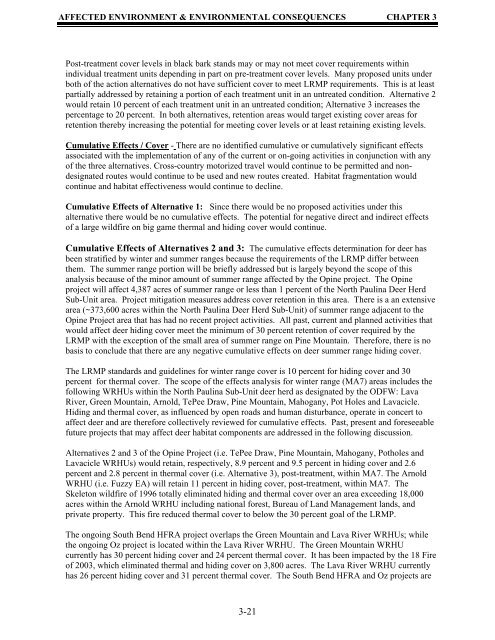Environmental Assessment
Environmental Assessment
Environmental Assessment
You also want an ePaper? Increase the reach of your titles
YUMPU automatically turns print PDFs into web optimized ePapers that Google loves.
AFFECTED ENVIRONMENT & ENVIRONMENTAL CONSEQUENCES CHAPTER 3<br />
Post-treatment cover levels in black bark stands may or may not meet cover requirements within<br />
individual treatment units depending in part on pre-treatment cover levels. Many proposed units under<br />
both of the action alternatives do not have sufficient cover to meet LRMP requirements. This is at least<br />
partially addressed by retaining a portion of each treatment unit in an untreated condition. Alternative 2<br />
would retain 10 percent of each treatment unit in an untreated condition; Alternative 3 increases the<br />
percentage to 20 percent. In both alternatives, retention areas would target existing cover areas for<br />
retention thereby increasing the potential for meeting cover levels or at least retaining existing levels.<br />
Cumulative Effects / Cover - There are no identified cumulative or cumulatively significant effects<br />
associated with the implementation of any of the current or on-going activities in conjunction with any<br />
of the three alternatives. Cross-country motorized travel would continue to be permitted and nondesignated<br />
routes would continue to be used and new routes created. Habitat fragmentation would<br />
continue and habitat effectiveness would continue to decline.<br />
Cumulative Effects of Alternative 1: Since there would be no proposed activities under this<br />
alternative there would be no cumulative effects. The potential for negative direct and indirect effects<br />
of a large wildfire on big game thermal and hiding cover would continue.<br />
Cumulative Effects of Alternatives 2 and 3: The cumulative effects determination for deer has<br />
been stratified by winter and summer ranges because the requirements of the LRMP differ between<br />
them. The summer range portion will be briefly addressed but is largely beyond the scope of this<br />
analysis because of the minor amount of summer range affected by the Opine project. The Opine<br />
project will affect 4,387 acres of summer range or less than 1 percent of the North Paulina Deer Herd<br />
Sub-Unit area. Project mitigation measures address cover retention in this area. There is a an extensive<br />
area (~373,600 acres within the North Paulina Deer Herd Sub-Unit) of summer range adjacent to the<br />
Opine Project area that has had no recent project activities. All past, current and planned activities that<br />
would affect deer hiding cover meet the minimum of 30 percent retention of cover required by the<br />
LRMP with the exception of the small area of summer range on Pine Mountain. Therefore, there is no<br />
basis to conclude that there are any negative cumulative effects on deer summer range hiding cover.<br />
The LRMP standards and guidelines for winter range cover is 10 percent for hiding cover and 30<br />
percent for thermal cover. The scope of the effects analysis for winter range (MA7) areas includes the<br />
following WRHUs within the North Paulina Sub-Unit deer herd as designated by the ODFW: Lava<br />
River, Green Mountain, Arnold, TePee Draw, Pine Mountain, Mahogany, Pot Holes and Lavacicle.<br />
Hiding and thermal cover, as influenced by open roads and human disturbance, operate in concert to<br />
affect deer and are therefore collectively reviewed for cumulative effects. Past, present and foreseeable<br />
future projects that may affect deer habitat components are addressed in the following discussion.<br />
Alternatives 2 and 3 of the Opine Project (i.e. TePee Draw, Pine Mountain, Mahogany, Potholes and<br />
Lavacicle WRHUs) would retain, respectively, 8.9 percent and 9.5 percent in hiding cover and 2.6<br />
percent and 2.8 percent in thermal cover (i.e. Alternative 3), post-treatment, within MA7. The Arnold<br />
WRHU (i.e. Fuzzy EA) will retain 11 percent in hiding cover, post-treatment, within MA7. The<br />
Skeleton wildfire of 1996 totally eliminated hiding and thermal cover over an area exceeding 18,000<br />
acres within the Arnold WRHU including national forest, Bureau of Land Management lands, and<br />
private property. This fire reduced thermal cover to below the 30 percent goal of the LRMP.<br />
The ongoing South Bend HFRA project overlaps the Green Mountain and Lava River WRHUs; while<br />
the ongoing Oz project is located within the Lava River WRHU. The Green Mountain WRHU<br />
currently has 30 percent hiding cover and 24 percent thermal cover. It has been impacted by the 18 Fire<br />
of 2003, which eliminated thermal and hiding cover on 3,800 acres. The Lava River WRHU currently<br />
has 26 percent hiding cover and 31 percent thermal cover. The South Bend HFRA and Oz projects are<br />
3-21
















